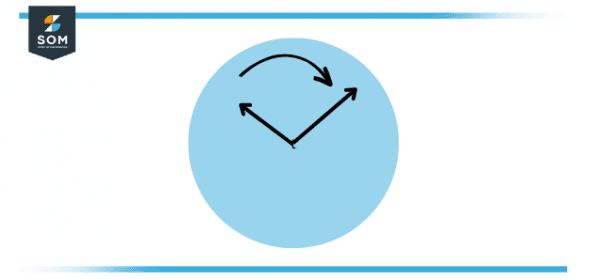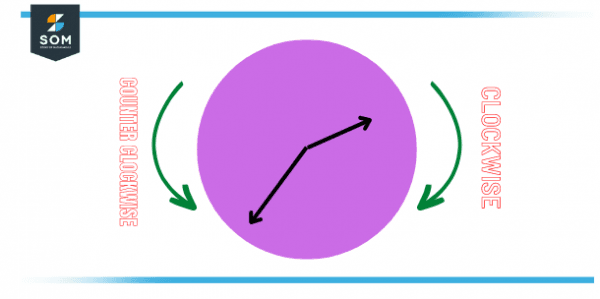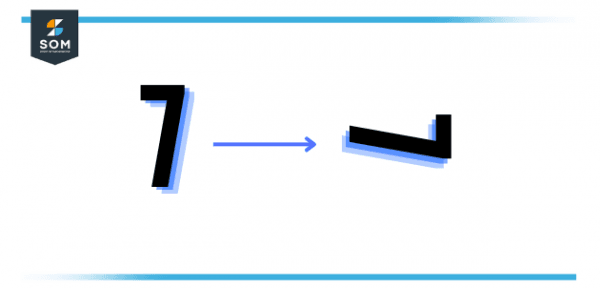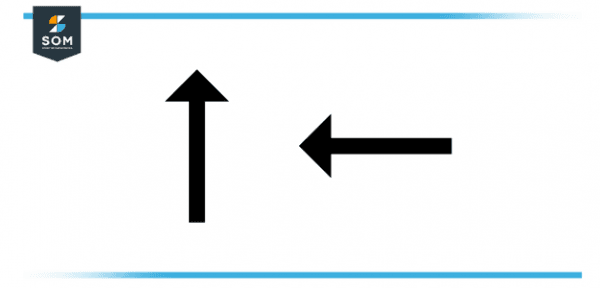JUMP TO TOPIC
Clockwise|Definition & Meaning
Definition
Two-dimensional rotation can happen in two possible orientations. The direction of the clock’s hands is the direction the Clockwise motion follows. Starting from the top and swinging to the right, then down, then moving to the left, and then again moving to the top. The opposing sense of rotation or trajectory is anticlockwise (ACW) or counterclockwise (CCW).
The clock’s name educates our minds with the guise of a timepiece swinging and informing us of the time. The needles of one such timepiece can also provide us with a direction’s sense. That is how the word clockwise arrived to be stamped, marking the direction of the motion of the needles of a clock.

Figure 1 – Wall Clock Follows Clockwise Direction
We notice the clockwise (CW) movement on several occasions in our daily lives. They are as follows; From opening the lid of a water bottle to rotating the knob of a gate, we see clockwise in many regular activities which direct us to revolve clockwise. The CW direction is the negative of the counterclockwise (CCW) direction, which marks a turn to the left, rather than the right.
Clockwise and Counter Clockwise
Clockwise and anticlockwise are methods of predicting the direction of a turn. Following the directions of the needles of a clock, clockwise implicates a bend to the right, In this case, the rotation direction is negative. Anticlockwise applies a bend to the left, opposing the movement of a clock’s hands. This is a positive rotation direction.
Both clockwise and counterclockwise are adverbs that explain the indication of an object in the right or left direction. The motion is usually in a circular manner which means it’s to the right at the top and the left at the bottom of the circle respectively clockwise. For counterclockwise (also referred to as anti-clockwise), the guide is in the opposite direction of the clockwise cycle.
As adjectives, clockwise means moving in a rotary movement like a timepiece does while counterclockwise is moving in a rotary manner to the left side.
Clockwise With Examples
Clockwise (CW) refers to the order of the hands of a clock. Since a clock is a computerized engine that is meant to indicate time, its needles tend to swing toward the right leaving a path behind them, describing what we direct to as the clockwise movement. Evaluate the movement of the hands of a clock. They swing from the top and move to the right, and then run down, then rotate left, and move back up likewise. The contrary of CW rotation is counterclockwise and represents the opposing sense of the cycle.

Figure 2 – Clock Example
Most screws are tautened, lids of bottles are closed or faucets and faucets are rotated off in the CW path. Thus, CW is a word used to indicate the rotational motion of an object.

Figure 3 – Rotation of Screws
The Right-Hand Rule
Ordinary nuts, screws, bolts, bottle caps, and jar lids are tensed (moved away from the observer) clockwise and eased (moved towards the observer) counterclockwise in harmony with the right-hand rule.
To exert the right-hand law, position the loosely grasped right hand on top of the object with the thumb indicating the required directive of the bolt, screw, or cap to move, and place the fingers curl, that is from the palm to the hand’s tip, will mark in which course one desires to rotate the bolt, nut, or screw to attain the expected effect. All the threaded entities observe this rule almost excluding rare left-handed anomalies described below.
Occasionally the opposite left-handed sense of threading is utilized for a certain reason. A thread might require to be left-handed to stop functional stresses from loosening it.
For instance, some old vehicles had right-handed lug bolts on the right tyre and left-handed lug bolts on the left tyre, so that, the auto moved forward, the lug nuts tended to tauten rather than loosen. For the pedals of the bike, the left nuts must be reverse-threaded to stop them from unscrewing during usage.
Likewise, the spinning wheel’s flyer whorl operates a left-hand thread to keep it from easing. A turnbuckle has right-handed lines on one point and left-handed threads on the other. Some gas fittings are left-handed to obstruct damaging misconnections for instance: oxygen fittings are operated right-handed, but propane, acetylene, and other explosive gases are unmistakably chosen by left-handed fittings.
Clockwise in Mathematics
Plane angles are generally estimated counterclockwise in general trigonometry and mathematics, beginning with $0^{\circ}$ or 0 radians implying instantly to the right, and $90^{\circ}$ indicating straight up. Nevertheless, in navigation, compass headers extend clockwise about the compass face, beginning with $0^{\circ}$ at the compass top, with $90^{\circ}$ to the right.
A circle is represented by the equation x = cost and y = \sint in a positive Cartesian plane and is summarized counterclockwise because the angle t proliferates in value, from the right-most end at the value of t = 0. The other formulation with $\cos$ and $\sin$ inter-changed provides a clockwise path from the uppermost point.
In the image shown below, the number “7” is rotated by 90 degrees CW. The movement does not dissemble the size or shape of the object, implying that even after a Clockwise movement, the symmetry of the object stays the exact same.

Figure 4 – Clockwise Rotation of Digit “7”.
Clockwise in Games and Activities
In broad, board games, card games, and numerous team sports the turn rotates in a clockwise direction and with a identified opponent to playing in the opposing direction that is counterclockwise. Traditionally turn is passed counterclockwise direction in many Asian countries.
In Western countries, when communication and conversation turns are passed in a circle, turns are guilelessly passed in a clockwise direction even though there are no restrictions to do so. Unlike with the games, there is commonly no disapproval when the activity begins in a counterclockwise direction. Notably, the baseball game is carried out in a counterclockwise direction.
A Solved Clockwise Problem
In which path has the arrow moved from the first place to the second?

Figure 5 – Change in Arrow Position
If the left side is the original arrow position and the right side is the new one, how much has it turned, and in which direction?
A. Two Turns Clockwise
B. Three Turns Counter Clockwise
C. Two Turns Counter Clockwise
D. Three Turns Clockwise
Solution
Answer:
D. Three Turns Clockwise
All images/mathematical drawings were created with GeoGebra.
